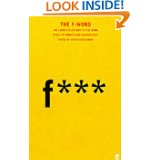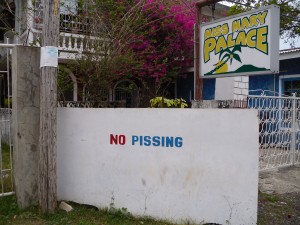
It doesn’t happen often, but I do occasionally get email from people asking—always very politely (well, almost always very politely)—whether I have ever considered producing a bowdlerized edition of my books.
Mind, none of them uses the word “bowdlerized”; I doubt most people under the age of forty have ever heard it. It comes from:
Thomas Bowdler (pronounced /ˈbaʊdlər/) (11 July 1754 – 24 February 1825), who was an English physician who published an expurgated edition of William Shakespeare’s work, edited by his sister Harriet, intended to be more appropriate for 19th century women and children than the original.
He similarly published an edited version of Edward Gibbon’s Decline and Fall of the Roman Empire. His edition was the subject of some criticism and ridicule and, through the eponym bowdlerise (or bowdlerize),[1] his name is now associated with censorship of literature, motion pictures and television programmes.
[Source: Wikipedia]
Now, what these readers would like me to expurgate from my own work, in order to accommodate their desires and sensibilities, ranges from sex-scenes (one very nice woman wrote to ask if I could produce an edition of OUTLANDER from which all the sex scenes were removed, because she was very eager to be able to discuss the book with her fifteen-year-old daughter, but didn’t think her girl was quite ready for the original. By biting my thumb rather hard (she was very nice, and meant well), I was able to refrain from writing back and asking her whether it might not be a trifle simpler just to wait a year or two for her daughter to be ready for the notion that married people have sex, than for me edit and republish a 700-page book–always assuming that I could convince any publisher that there was a market for such a thing? (My guess is that unless her daughter has been living under a rock for the last five years, she knows a lot more than I’ve ever thought of putting in a book, but possibly her mother doesn’t let her watch television)) to Bad Words in general (“I notice people say “Fuck” a lot in your more recent books,” one reader wrote, rather censoriously. “Jamie doesn’t even know what that word means in OUTLANDER!” Well…he’s probably picked up a few expressions from Claire over the last twenty years. But Jamie’s not usually the one saying that word, even in the later books. It would be pretty common to Roger, though, as well as to some of the coarse folk who live in the backwoods), to—very specifically—the use of the Lord’s name (only “Jesus” or “Christ,” evidently. “God” doesn’t appear to bother these particular readers in this context, let alone local variants like “the Holy Spirit”.).
OK. Approaching these concerns from last to first:
I have every sympathy for someone whose religious sensibilities make them uncomfortable with blasphemy, whether casual or heart-felt. I personally am very disturbed by people who curse or use profanity and crude language in restaurants, and a terrible lot of people do these days. (I don’t think it’s just the places I eat in…)
On the other hand, I’m kind of bemused that not one of the people who take the Third Commandment so much to heart that they are horrified at seeing it broken in print are evidently bothered in the slightest by the shattering of the other nine commandments that goes on in these novels. Graven images, skipping church on Sunday, dishonoring one’s parents, bearing false witness, coveting oxen, asses, wives…theft, murder, fornication, adultery–yeah, we don’t mind seeing any of that. The J-word, though….
(Let me pause for a moment of didacticism here, in which I will attempt to explain the subtleties of the terms blasphemy, profanity, and obscenity. To wit:
blas•phe•my
Show Spelled[blas-fuh-mee] Show IPA
–noun, plural -mies.
1. impious utterance or action concerning god or sacred things.
2. Judaism .
a. an act of cursing or reviling God.
b. pronunciation of the Tetragrammaton (YHVH) in the original, now forbidden manner instead of using a substitute pronunciation such as Adonai.
3. Theology . the crime of assuming to oneself the rights or qualities of God.
4. irreverent behavior toward anything held sacred, priceless, etc.: He uttered blasphemies against life itself.
pro•fan•i•ty
Show Spelled[pruh-fan-i-tee, proh-] Show IPA
–noun, plural -ties for 2.
1. the quality of being profane; irreverence.
2. profane conduct or language; a profane act or utterance.
3. obscenity ( defs. 2, 3 ) .
Profane
–adjective
1. characterized by irreverence or contempt for god or sacred principles or things; irreligious.
2. not devoted to holy or religious purposes; unconsecrated; secular ( opposed to sacred).
3. unholy; heathen; pagan: profane rites.
4. not initiated into religious rites or mysteries, as persons.
5. common or vulgar—verb (used with object)
6. to misuse (anything that should be held in reverence or respect); defile; debase; employ basely or unworthily.
7. to treat (anything sacred) with irreverence or contempt; violate the sanctity of: to profane a shrine.
obscenity – 5 dictionary results ob•scen•i•ty
Show Spelled[uh b-sen-i-tee, -see-ni-] Show IPA
–noun, plural -ties for 2, 3.
1. the character or quality of being obscene; indecency; lewdness.
2. something obscene, as a picture or story.
3. an obscene word or expression, especially when used as an invective.
[Source for all of the above: dictionary.com]
Let me state for the record that no one in any of my books has ever pronounced the Tetragrammaton in the original. Not once.
And Jamie Fraser is on record as stating that he only _felt_ like God (while having sex with his wife); he never said he _was_. So I think we’re clear on those particular charges of blasphemy. I’ll get back to the question of impious utterances in a bit.
Now, if you read further on the dictionary.com site (and others), you’ll find that blasphemy, profanity, and obscenity are often used as synonyms for each other—and they often overlap, depending on usage–but there are differences.
The F-word (I’m sorry, I was raised as a Catholic and I have considerable trouble saying that word out loud. Fortunately most of the people in my books have no such scruples) is often obscene, and quite possibly profane, but not blasphemous. I.e., there’s no mention of God or anything sacred (well, not in the word itself. If you started applying it to sacred concepts—which a good many cultures do, in terms of insult (French-Canadian Catholics, for one)—then that’s different). (Ulster Protestants given to tattooing such sentiments as “F— the Pope” on their foreheads (no, I’m not kidding; some of these people feel strongly about their sectarian sensibilities) are not committing blasphemy _per se_, as while the Pope may be a person of reverence, he isn’t God. “F the P” is therefore mere profanity.)
Profanity can also be blasphemous, if an invocation of God is involved—but if you leave God out of it, profanity is not usually blasphemy. It’s just irreverence, and that’s pretty firmly in the eye of the beholder and the standards of the times. Go to, thou saucy fellow!
As for obscenity…the Supreme Court couldn’t do better than, “we know it when we see it,” and I don’t propose to try to top that.
Anyway, the point here is that it’s only blasphemy (or what is perceived as blasphemy) that concerns the “I do wish you would not take the Lord’s Name in vain” letters. One reader informed me that she had gone through my books with a black marker and obliterated all such usages, so that she could read the books in comfort. I congratulated her on her helpful ingenuity; genius often lies in simplicity.
But let’s look at that. Does any use of the C-word (the six-letter one) or the J-word that is not portrayed as a prayer or a scriptural reference constitute blasphemy?
I don’t think so.
Here we come to the “impious utterances” definition of blasphemy. “Thou shalt not take the name of the Lord thy God in vain.” Well…what is “in vain”?
When we did catechism class back in the day, we were taught that “in vain” meant that you mustn’t use God’s name to curse somebody, in the “You g_d_ son of a four-legged what-not..!” kind of way. (Catholics, btw, do include “God” (and the Holy Spirit, for that matter) as being “the Lord’s name.”). Using God’s name as a casual interjection—“Jesus, it’s hot,” or “God, I’d kill for a beer,” was crude and thoughtless and a well-brought-up person ought not to do it—but it wasn’t blasphemy, either.
People in my books do in fact use this sort of casual reference fairly often—because men in certain professions (soldiering, for one) and in the exclusive company of other men, very frequently _do_ do that. (You notice that the women in my books don’t do this.)
In my experience (owing to unorthodox career choices, most of my colleagues and close friends were men, up to my early forties), men who do this are customarily calling unconsciously upon God to witness something, asking for casual assistance in a moment of stress, or merely expressing an intensification of emotion (amazement, shock, anger), and do not actually intend offense to their comrades or impiety toward the Almighty.
Now, plainly opinions differ on just what’s an impious utterance and what’s not. That being so, though, we’ve got a few different considerations going here:
1. The notion that a writer ought to try never to offend anyone’s conception of morality or decency.
2. Whether a writer should or should not portray offensive behavior (i.e., behavior condemned by a majority of the populace), and if so, under what circumstances?
3. The question of how far historic speech might differ from modern speech, and whether an historical novelist should take that into account?
OK, #1 is simple. Putting aside aesthetics and the moral imperatives of art, it’s flat-out physically impossible to write something that won’t offend somebody. Ergo, the notion that a writer should try to do so is ludicrous.
#2 is also pretty simple. People don’t always behave well; the briefest glance at the television news makes that pretty clear. If art (whether novels, photographs, or anything else) is going to serve as a reflection of or a reflection on humanity, it’s going to show people doing stuff that may not be moral by anybody’s compass. The essence of art is conflict. Conflict may be difficult to look at (or utterly fascinating. Sometimes both at once), but you can’t do without it and make art.
#3. Now, historicity. Language evolves, and so does social custom. What is obscene or blasphemous in one time often isn’t, in another. If you called a man a fig-licker today, he would probably merely blink at you, whereas them was duelin’ words in the 18th century.**
A writer dealing with historical settings has a lot of things to consider, and one of these is how much “historical” language or figures of speech to use, and how to portray historical characters in such a way that they seem realistic and empathetic to a modern audience, but still belong plainly to their own time.
Well, one of the ways in which you do this is to use figures of speech that are extremely common, and likely always have been, as well as those particular to a specific age. And calling upon the name of the Almighty in moments of strong emotion and/or casual conversation has probably been part of human speech since people discovered the concept of a deity.
Now, I could go on and on (well…even more on and on {g}) about this business, because I find it fascinating, but I do have work to do. I think the best I can do here may be to quote a bit from THE OUTLANDISH COMPANION. This letter was written as part of an exchange with a courteous gentleman who’d written to object to the F-word, which emerged from one of the audiobooks as he was driving with his four-year-old grand-daughter, and is included in the “Controversy” section of the COMPANION:
“Well, I have children myself (11, 13, and 15 at the moment), and we try not to expose them to “bad language,” either, in spite of the fact that they all know all the words already (there’s still some point to insisting that these are not suitable for civilized conversation, after all).
The thing is, though–my books are definitely written (and carefully written at that) for adults. When I do use bad language in the books (oddly enough, I never use it, personally; never), it’s because it seems to me to be called for, by the circumstances and character. In the case of the F-word in DRUMS (I did use that same word in all the other books, by the way, though sparingly), it’s used by a young man in the grip of angry (and sexually motivated) passion, in the late 1960s. Given this character, this time period, and this set of circumstances, his language seemed entirely appropriate.
Now, one reason for insisting that bad language not be used in everyday discourse is, of course, that it’s low-class and offensive. One other reason–equally important, in my opinion–is that such language does have its own legitimate purpose; that is, to express feeling that is also beyond the limits of normal civilized discourse. To use such words casually deprives them of their impact.
You can see that, in the scene in question in DRUMS. If Roger normally spoke like that, the reader wouldn’t have (what I hope is) the impression of a man driven almost beyond endurance, and holding on to his notions of decent behavior with great effort.
Okay. So, the point is that when I do use strong language, I have a specific reason for doing so. It really doesn’t seem reasonable to me to eradicate such language–chosen and used carefully, to a purpose–on the grounds that someone might someday wish to listen to a taped version of an adult book in the presence of a small child.”
(My correspondent very graciously thanked me for hearing his concern, btw, and agreed with my conclusion.)
Right. Well, moving backward from blasphemy and Rude Speech, we come back to the inclusion of sex in my books. I can honestly say that of a thousand letters I get that mention this, 999 readers think there should be more sex. {g}. But there is the occasional one who thinks that the inclusion of sex lowers the tone, impairs my literary reputation, or should be omitted so as to make the books more…um…acceptable {cough} to younger (or possibly older; you wouldn’t believe how many people think their elderly parents or grandparents would enjoy my books but be put off by the sex*) readers.
Well, I think my literary reputation will have to take care of itself; I can’t do anything but write the best books I can, and history and the readers will make of them what they want to.
I do think that the sex scenes are both necessary and integral to the story, or they wouldn’t be there. These aren’t romance novels, but they are (among other things) the story of a very long and complex marriage. Now, there may possibly be long and successful marriages that don’t include sex, but I don’t personally know of any.
Neither are any sex-scenes included for the sake of gratuitous titillation (any titillating that happens is purely fortuitous, I assure you), nor are any of them just about sex. They have structural and emotional reasons for being where they are, and the book would not be the same story, nor have the same complexity, without them.
Still, the bottom line here is the Eye of the Beholder. There is no book that will say the same thing to all readers. A good book will say something different each time it’s read, even by the same person. And each reader brings his or her experience, background, prejudices, desires, and perceptions to the reading.
That being true, there’s little point in bowdlerization. What offends one person will be revelation and elevation to the next. That’s why we have a great variety of books.
“If thine eye offend thee, pluck it out,” seems a trifle extreme here as a response—but if there are particular things in my books that annoy or offend a reader as an individual, the ultimate power to control these does lie with the reader, not with me.***
Thank you for reading!
*(I am irresistibly reminded here of a book-signing event in Chicago, where I signed books for a grandmother, her daughter, and grand-daughter (intergenerational—and multi-gender—trios are pretty common at my signings). I was chatting with the grandmother while signing a book for her grand-daughter, and she said, “You know, I was in the middle of VOYAGER and I turned to my grand-daughter and said, ‘I’ve just had the most terrible thought! We’re both lusting after the same man!’”)
**To save you looking it up, the modern equivalent slang would be “muff-diver.” Weirdly enough, I don’t think there’s a female slang version of this epithet, though there is a purely formal descriptive term. But when was the last (or the first, for that matter) time you heard someone called a fellatrix?
*** A good-quality Sharpie costs about $1.79.















